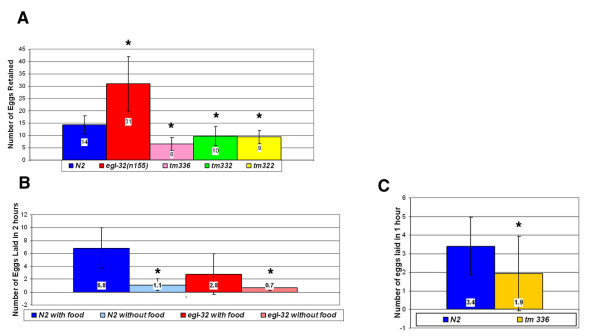Figure 1.
Egg Retention – (a) egl-32(n155) animals retain about twice as many eggs as wild type animals. Animals containing a deletion in T08G11.2 (tm336) and animals containing deletions in two of T08G11.2's homologues (tm332 and tm322) retain far fewer eggs than wild-type animals. 36 wild-type N2 animals, 36 egl-32(n155) animals, 35 tm336 animals, 67 tm332 animals and 144 tm322 animals were used in this assay. * Statistically significant difference. Student t-test value < 0.05. Error bars in this and all figures show standard deviation. (b) – Mutant egl-32 animals lay about half as many eggs as wild-type animals. However, mutant egl-32 animals do respond normally to food cues. They begin to lay even fewer eggs in the absence of food. 26 N2 animals in the presence of food, 39 N2 animals in the absence of food, 26 egl-32 animals in the presence of food, and 38 egl-32 animals in the absence of food were used in this assay. * Statistically significant difference. Student t-test value < 0.05. (c) – T08G11.2 deletion mutants (tm336) lay significantly fewer eggs than wild-type animals. However, they retain late stage embryos. * Statistically significant difference. Student t-test value < 0.05.

